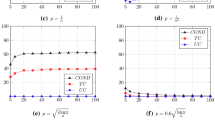Abstract
A tournament can be viewed as a majority preference relation without ties on a set of alternatives. In this way, voting rules based on majority comparisons are equivalent to methods of choosing from a tournament. We consider the size of several of these tournament solutions in tournaments with a large but finite number of alternatives. Our main result is that with probability approaching one, the top cycle set, the uncovered set, and the Banks set are equal to the entire set of alternatives in a randomly chosen large tournament. That is to say, each of these tournament solutions almost never rules out any of the alternatives under consideration. We also discuss some implications and limitations of this result.
Similar content being viewed by others
References
Banks JS (1985). Sophisticated voting outcomes and covering relation. Soc Choice Welfare 1: 295–306
Bell CE (1981). A random voting graph almost surely has a Hamiltonian cycle when the number of alternatives is large. Econometrica 49(6): 1597–1603
Bollobás B (2001). Random graphs, 2nd edn. Cambridge University Press, Cambridge
Chernoff H (1952). A measure of asymptotic efficiency for tests of a hypothesis based on the sum of observations. Ann Math Stat 23: 493–507
De Donder P (2000). Majority voting solution concepts and redistributive taxation. Soc Choice Welfare 17(4): 601–627
Dutta B (1988). Covering sets and a new Condorcet choice correspondence. J Econ Theory 44(1): 63–80
Fishburn PC (1977). Condorcet social choice functions. SIAM J Appl Math 33(3): 469–489
Grofman B, Owen G, Noviello N and Glazer A (1987). Stability and centrality of legislative choice in the spatial context. Am Pol Sci Rev 81(2): 539–553
Johnson NL, Kotz S and Kemp AW (1992). Univariate discrete distributions, 2nd edn. Wiley, New York
Laffond G, Laslier J and Le Breton M (1993). The bipartisan set of a tournament game. Games Econ Behav 5(1): 182–201
Laffond G, Laslier JF and Le Breton M (1995). Condorcet choice correspondences: a set-theoretical comparison. Math Soc Sci 30(1): 23–35
Laslier JF (1997). Tournament solutions and majority voting. Springer, Berlin
McKelvey RD (1976). Intransitivities in multidimensional voting models and some implications for agenda control. J Econ Theory 12: 472–482
McKelvey RD (1986). Covering, dominance and institution-free properties of social choice. Am J Pol Sci 30: 283–314
Miller NR (1977). Graph-theoretical approaches to the theory of voting. Am J Pol Sci 21(4): 769–803
Miller NR (1980). A new solution set for tournaments and majority voting. Am J Pol Sci 24(1): 68–96
Moon JW (1968). Topics on tournaments. Winston, New York
Moulin H (1986). Choosing from a tournament. Soc Choice Welfare 3(4): 271–291
Niemi RG and Weisberg HF (1968). A mathematical solution for the probability of the paradox of voting. Behav Sci 13(4): 317–323
Okamoto M (1958). Some inequalities relating to the partial sum of binomial probabilities. Ann Inst Stat Math 10: 29–35
Plott CR (1967). A notion of equilibrium and its possibility under majority rule. Am Econ Rev 57: 787–806
Schwartz T (1972). Rationality and the myth of the maximum. Nous 6: 97–117
Schwartz T (1990). Cyclic tournaments and cooperative majority voting: a solution. Soc Choice Welfare 7(1): 19–29
Author information
Authors and Affiliations
Corresponding author
Rights and permissions
About this article
Cite this article
Fey, M. Choosing from a large tournament. Soc Choice Welfare 31, 301–309 (2008). https://doi.org/10.1007/s00355-007-0279-3
Received:
Accepted:
Published:
Issue Date:
DOI: https://doi.org/10.1007/s00355-007-0279-3




